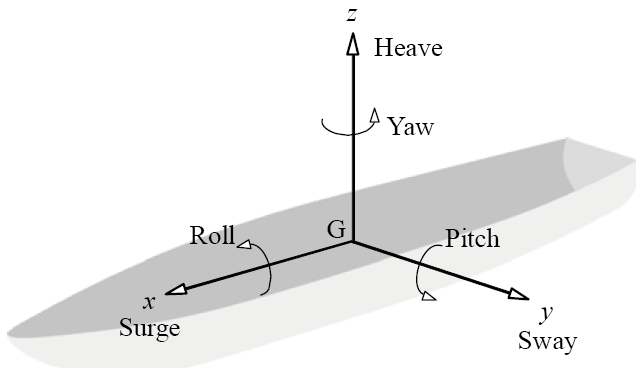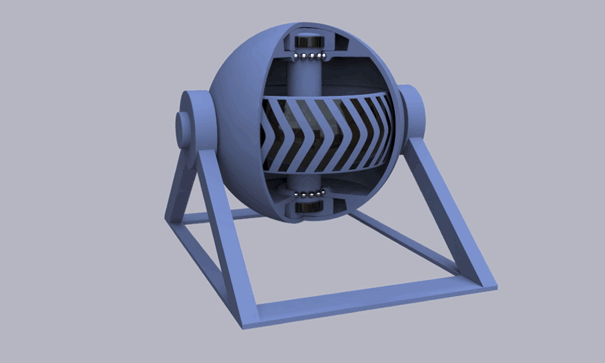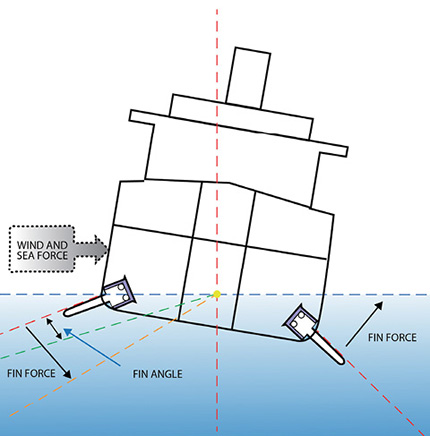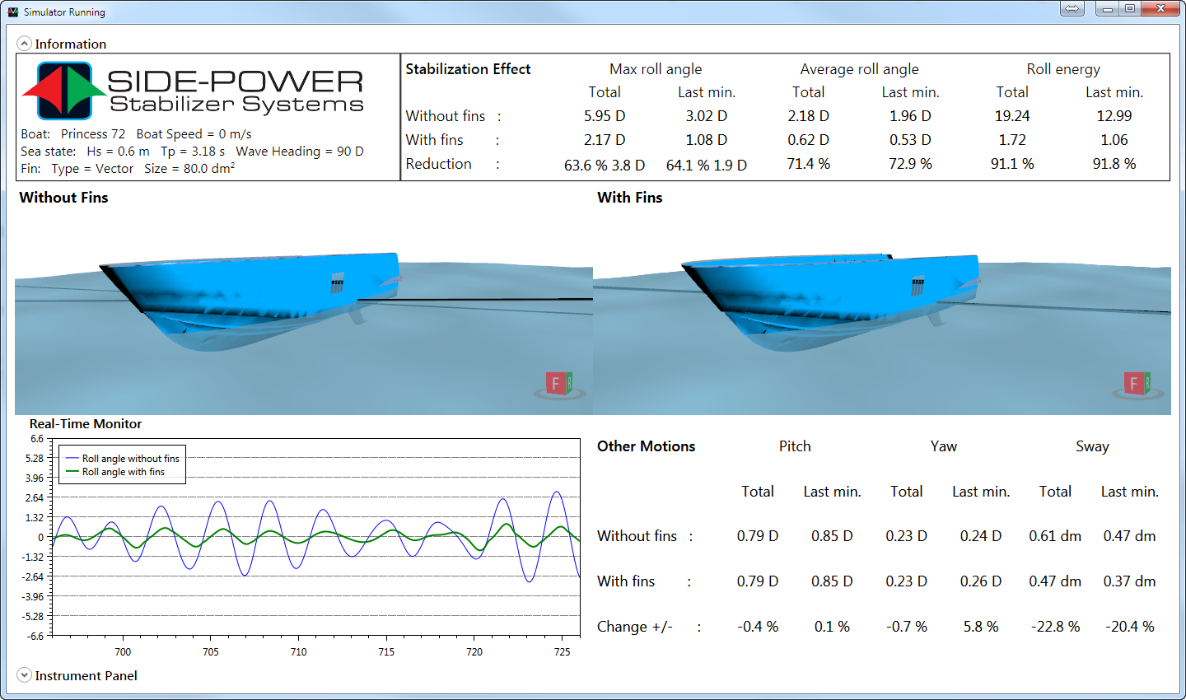Most owners want to reduce the motion that makes people seasick on their boat, and many have heard about stabilization systems provided by fin stabilizers and gyros. But which is better? And specifically, how do advanced curved-fin systems like Sleipner Vector Fins match up with the most popular gyro systems? Let’s start with the basics and go from there.
800x250.jpg)
What are the six degrees of freedom of a boat?
There are six motions a boat can make and some are more likely than others to make people seasick. Imagine drawing a line down the middle of the boat from bow to stern and another line from side to side, and finally a third line straight up from the center of the boat. The boat can move up and down, side to side, and forward and aft in the direction of each axis. It can also swing or rotate on each axis. Two motions per axis equals six motions total: surge, roll, pitch, sway, heave, and yaw.

Which boat motions most commonly make people seasick?
While all of the above boat motions can cause seasickness, the roll is the most significant factor, which probably won’t surprise anyone who’s spent much time in a boat. Another big factor is sway, the side-to-side motion. You don’t notice sway so much; it can be subtle, but it can really affect people. It’s not so much the degree of motion—how many degrees the boat rolls or how many feet (or meters) it moves in sway— that affects seasickness, but the combination of angle, frequency and acceleration of that movement. If you can reduce the degree and acceleration of the roll, you can go a long way towards reducing the incidence of seasickness.
What other factors affect how quick or sudden the motion of the boat is?
The hull design – combined with the wave’s size, shape and time between waves (frequency) – makes a big difference in how a boat feels and behaves. For example, a narrow, round-bottom boat (e.g. a sailboat) and a wide, flat-bottom boat (e.g. a powerboat) behave quite differently. You might think the flat-bottom boat would be more stable, and in smooth water, it is, but that also means it will hug the surface of the wave more readily in longer waves and that makes it harder to stabilize.
By comparison, the narrower, rounder shape typically will be easier to stabilize. Note these are general rules, and the bottom line is that the boat will roll the most when the natural roll period of the boat is equal to the roll period of the wave. In this scenario, the momentum of the rolling boat causes it to continue to roll even as the wave passes, thus creating the greatest degree of roll. Eventually, the boat will stabilize somewhat until the cycle starts anew.
Which boat motions can gyros and fin stabilizers counteract?
No stabilizer system will counteract some of these motions, particularly heave and to an extent, pitch. But Vector Fins in particular can make a big difference in yaw, roll and sway, which is good, since those last two are the two motions most likely to cause seasickness. Because gyros do not have an appendage in the water, they do not influence sway and yaw.
What is a boat gyro stabilizer and how does it work?
The gyro stabilizer is essentially a large, heavy spinning disc, turning at very high RPMs, sort of like a throwing wheel used to make a clay pot. As the boat rolls, the spinning wheel will naturally angles forward or aft, imparting a force on the hull in opposition to the roll. As a series of waves try to roll the boat, the gyro constantly tilts forward or aft, within the limits of the hydraulic cylinders controlling it. This “precession” of the gyro is governed by software that senses the motion of the hull and controls the rate of precession to avoid jerky, unnatural, and uncomfortable motion.

What are fin stabilizers and how do they work?
Think of an airplane, which you can bank by changing the air flow over the ailerons (trailing-edge flaps) on the plane’s wings and tail. Fin stabilizers use water flow in a similar way, causing a boat to “bank.” If the boat rolls in one direction, we angle the fins to generate an opposing force. If you have ever stuck your arm out of the car window on the highway, you know that angling your flat hand will cause your arm to go up or down depending on which direction you rotate your hand. The fins moving through the water basically create the same effect. When the boat is not moving, there’s no water flow across the fins, so motion is created by moving the fins rapidly side-to-side like a hovering fish. By creating a force in opposition to the boat’s roll, the boat will stabilize.

What motions impact the effectiveness of boat stabilization systems?
The frequency of the wave makes the most difference—that’s the time from the top of one wave to the top of the next. There is also something called the “roll period” of the boat. This is the time it takes for a boat to roll to one side, then the other, and then back to the center. A 3.5- to 4-second roll period is what people are most sensitive to in terms of motion sickness. It also happens to be the natural roll period of most motor yachts in the range of about 55 to 90 feet, so stabilizers become particularly useful on these yachts. Of course, stabilizers will control unwanted boat roll on any size boat.
Do gyro and fin stabilizers work better when a boat is at-anchor or underway?
When a boat is at-anchor or underway, both systems will improve stability in both situations if sized properly. Fin stabilizers work best when the boat is moving, but bigger fins are needed for optimum at-rest performance than for underway performance. That’s a trade-off that may lead to different decisions, depending on how a boat will be used. Gyros, on the other hand, work best when the boat is stationary, or moving at slow speeds; larger gyros are needed to provide good stabilization when the boat is underway. This also requires analysis of how the boat will be used and when the best performance is most important.
The fundamental difference between the two systems is that fins generate greater and greater force as the rate of water flow increases (i.e., the faster the boat is going). This force increases exponentially with speed, which is a massive advantage compared to gyros. A gyro system generates the same amount of force, no matter what speed the boat is moving, so it is less effective the faster you go.
When a boat is planing, it is hardest to stabilize; the boat becomes more rigid on a plane, so it wants to assume the angle of the wave. That is, it wants to roll with the wave. Due to the tremendous force generated by the foils at speed, here’s where you can take the greatest advantage of the fins’ underway capabilities—and in particular the advanced shape of Sleipner Vector fin stabilizers. The fins have more power to stabilize the boat exactly when the boat is hardest to stabilize, and as an added benefit, will counteract list from cross winds or weight distribution. Conversely, as mentioned above, a gyro’s force remains constant, restricted by the size and speed of the gyro flywheel, and it can’t correct for list.
In what special applications do gyros or fin stabilizers excel?
Gyros are often chosen for sportfish boats, especially on the East Coast where captains often back down really hard when a fish is on the line, and may also use thrusters to keep their position relative to the fish. The fin stabilizers need to center and be parallel to the keel when backing down. Reversing also generates a lot of cavitation and may damage the back of a fin after prolonged exposure. When backing down normally for docking or maneuvering, fins center quickly and there’s no issue.
On the West Coast, captains tend to fish differently and don’t seem to have this problem. On a workboat with nets, an appendage also may be less desirable.
What data is available on the effectiveness of Vector Fin and gyro stabilizer systems?
Before you buy Vector Fins or a gyro system, product manufacturers can take detailed boat-model data and simulate how the boat will respond in different sea conditions. You can model the roll of the boat and how different size fins or gyros will reduce the motion on a percentage basis, which enables decisions to be made about the best size to put on a given boat. It’s important to remember that not all waves are the same and over a period of time, there will not only be different sizes but different periods, which will amplify and reduce roll naturally. Stabilizer manufacturers can graph the effect of a series of variable-sized waves over time, with and without their system running, and then superimpose the two graphs to show the improvement. As an example, if you graph the motion over 10 minutes, there will be times when a stabilizing system may reduce the motion by, say, 92 percent and other times by less, say, 80 percent. It’s important to ask for the full graph, not a small segment of it, so you can see the true effectiveness over time. Below is an example from Sleipner simulating a Princess 72 with and without Vector Fins. 
What are the pros and cons of gyro stabilizer systems?
Gyros have no appendage, they are relatively small and compact, and they are well-engineered to minimize the intense heat generated on the bearings by the spinning mass. Gyros come in an attractive package and work well in many circumstances.
Disadvantages of the gyro systems are that they are less effective underway, are heavy, and in some cases servicing requires removing the unit from the boat. For a 30-knot boat, a gyro has to be much bigger–perhaps bigger than space allows–to equal Vector Fins’ performance, so sometimes two or three gyros will be installed. The systems can take up to an hour to “spin up” before they provide full stabilization, also generate noise, may require structural reinforcement, and with few exceptions are wholly dependent on AC power off a generator. In certain sea conditions, their effectiveness is also limited by stroke or precession distance, and when it’s time to replace the main bearings, most gyros must be removed from the boat and returned to the factory for service.
What are the pros and cons of Sleipner Vector Fin stabilizers?
The advantages of Vector Fin stabilizers include the fact that their power increases with speed exponentially and that they generate lift as well as stability, which negates the effect of drag (unlike straight fins). Vector Fins also provide both at-rest and underway stabilization, allow you to bank into turns, and reduce unwanted motions of sway and yaw by up to 30 to 50 percent compared to straight fins. They counteract crosswinds and list, are lighter than gyros by thousands of pounds (depending on size), and allow maintenance of bearings and cylinders to be done in place.
Those stabilizers using hydraulic power can typically use a PTO (power take-off) hydraulic pump on the boat’s engine to get free power underway (it uses AC from a genset or shorepower at rest). An accumulator in the system means less noise and instant response. In fact, the system is virtually silent. The stabilizing force of Vector Fins is directed more vertically than straight fins, increasing efficiency and lift; you can therefore use smaller fins for the same power or larger fins to gain 30 to 50 percent more power than straight fins.
Disadvantages of all fins include the fact that they are appendages and can therefore cause entanglement or be damaged. They create drag, which may be offset by gains in fuel efficiency and speed in the case of Vector Fins. They can also cause sway and yaw, and at anchor they are limited by the length of the fin’s stroke. Also, they need to be positioned roughly in the middle of the boat so when retrofitting an older boat this may sometimes pose a challenge. Their location also requires ample structure and support for the loads generated.
Broadly speaking, what is the price difference between fin vs. gyro boat stabilizers?
A detailed analysis of expectations, requirements, and each boat’s suitability should be undertaken by the yard doing the work, but all else being equal, Vector Fins may be equal to or possibly a little less than a gyro installation. There are many factors that will dictate higher and lower costs—for example structural refits needed to add a gyro sometimes make a big difference. Another question is whether there is space to install either system, and/or what existing equipment will need to be moved in order to create the space for an installation.
The biggest variable in our experience is the owner’s expectations. What’s most important? Stabilization at any speed, or optimizing for at-rest performance? If at-rest stabilization is the priority, a smaller gyro will cost less than one that is two or three times the size, which may be what is required for any-speed stabilization. For any-speed stabilization, the equipment cost of a Sleipner Vector Fin system would be significantly less than a gyro system.
To learn more, check out the full Sleipner Vector Fin offering by downloading the catalog! And for more information on the boat stabilizers we have to offer here at Imtra, be sure to contact us today to speak with a member of our team.